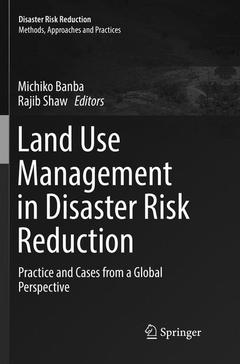Land Use Management in Disaster Risk Reduction, 1st ed. 2017 Practice and Cases from a Global Perspective Disaster Risk Reduction Series

This book provides a wide range of studies on methods of assessing natural disaster risks and reducing those risks in the context of land use. A major benefit of the book is that it presents extensive research and practices from interdisciplinary perspectives through case studies of land use management against various natural disasters. The natural hazards include earthquakes, tsunami, floods, and other disasters, with case studies ranging from urban areas to areas with natural environments such as mountains, coasts, and river systems. By quantitative and qualitative analysis, this work illustrates how interactions between natural and human environments create natural disasters, and how disaster risks can be managed or reduced through methods related to land use.
This book also covers a variety of challenges in land use management with sample cases from Asia as well as the United States and Europe. The main purpose is to provide greater insight into studies of natural disaster risks from the perspective of land use and the possibility of non-engineering methods to reduce those risks. This goal can be achieved through management of land use against various natural hazards in diverse environments.Michiko Banba is an associate professor at the Education and Research Center for Disaster Reduction of the University of Hyogo, Japan. Her research field is land use, land management, and urban and regional management in the context of disaster risk reduction. Her research field is mainly in Asian counties including Japan, Indonesia, and Nepal. She works closely with local governments and communities to plan and develop policies and countermeasures to reduce disaster risks and to build the capacity of communities against disaster.
Rajib Shaw was a professor in the Graduate School of Global Environmental Studies of Kyoto University, Japan. He worked closely with local communities, NGOs, governments, and international organizations, including the United Nations, especially in Asian countries. He is currently the co-chair of the United Nations Asia Science Technology Academia Advisory Group (ASTAAG) and the president of the Asian University Network of Environment and Disaster Management (AUEDM). His research interests are community-based disaster risk management, climate-change adaptation, urban risk management, and disaster and environmental education. He has published several books in the field of disaster and environmental management and is also the chief editor of the Asian Journal of Environment and Disaster Management.
Positions disaster risk reduction in the mainstream for land use planning
Introduces governance issues related to land use and disaster risk reduction
Explains the experiences and lessons of research and varied practices across the globe
Includes supplementary material: sn.pub/extras
Date de parution : 07-2018
Ouvrage de 476 p.
15.5x23.5 cm
Disponible chez l'éditeur (délai d'approvisionnement : 15 jours).
Prix indicatif 158,24 €
Ajouter au panierDate de parution : 12-2016
Ouvrage de 476 p.
15.5x23.5 cm
Disponible chez l'éditeur (délai d'approvisionnement : 15 jours).
Prix indicatif 158,24 €
Ajouter au panier

